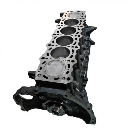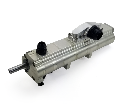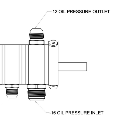PHR/Dailey Dry Sump System Builder for 2JZ
Converting to Dry Sump Oiling System
What are the benefits?
A dry sump system is an oiling system used in high-performance or racing vehicles. Unlike a wet sump system found in many production cars, such as the 2JZ, where the oil is stored in a pan underneath the engine, a dry sump system stores oil in a separate reservoir or tank, mounted externally.
Here's how it works and why it's beneficial:
- Increased Horsepower: The combination of reduced windage losses, improved oil control, better ring seal enhanced cooling, reduced crankcase pressures and better oil quality provided by a dry sump oil system all contribute to increased engine power. Follow as we delve into these benefits a little deeper.
- Reduced Windage: A dry sump system reduces windage by continuously scavenging oil from the engine's crankcase, maintaining a lower pressure environment. This decreases resistance to piston movement, allowing the engine to operate more efficiently and produce more power, especially crucial in boosted applications where every bit of power counts.
- Enhanced Oil Control and Quality: With a separate oil reservoir,
adjustable oil volume and continuous scavenging, a dry sump system
promotes better oil control throughout the engine. This helps prevent oil
starvation during high-G driving maneuvers and launches, ensuring
consistent lubrication to critical engine components. Also reducing heat,
windage effects, better filtration and defoaming all lead to a system that
will keep oil film quality up on your bearing and journal surfaces,
meaning increased health and longevity of your internals. The dry sump pump will operate efficiently well beyond the normal rpm limitations of typical sump setups.
- Improved Turbocharger Performance: In boosted applications, a dry sump system can also benefit turbocharger performance and health. By reducing the risk of oil contamination and leaks, it helps preserve the integrity of turbocharger seals and extends their lifespan, ensuring consistent boost delivery and overall engine performance.
- Reduced or Negative Crankcase Pressure: Creating a vacuum in the crankcase further enhances engine performance by offsetting positive crankcase created by combustion process. This minimizes resistance to piston movement, decreases blow-by, improves piston ring seal, and prevents oil seal failures, contributing to improved efficiency and reliability in boosted setups.
- Piston Oil Ring Seal: The effectiveness of piston ring seals is closely intertwined with the operation and performance of a dry sump oil system. By maintaining a tight seal, managing blow-by gases, reducing windage losses, and regulating oil control, piston rings contribute to the overall efficiency, reliability, and performance of a dry sump-equipped engine. Leading to better compression and increased performance.
- Engine Program Longevity: The consistent oil supply,
improved lubrication, and reduced stress on engine components offered by a
dry sump system contribute to increased engine program longevity and
reliability. This is particularly important in high-performance or racing
applications where engine durability is paramount.
- Space Considerations: In some high-performance applications, especially in vehicles with low ground clearance or tight engine compartments, a dry sump system allows for a shallower oil pan design. This can help with packaging and overall vehicle design, providing more flexibility in optimizing weight distribution and aerodynamics.
In summary, a combination of a dry sump system and maintaining a vacuum
in the crankcase offers a comprehensive solution for optimizing engine
performance in boosted applications. These technologies work together to reduce
windage, improve piston ring seal, enhance oil control, prevent oil leaks, and
improve turbocharger performance, ultimately enhancing overall engine
efficiency, reliability, and power output while also providing benefits in
packaging and design flexibility.
Dry Sump System Builder Guide
There are lots of options when building a Dry Sump System, our goal is to make the process as easy as possible. Below we will go over the various selection items for our kit. Once you add to cart you will have a chance to add on other accessories that will be needed to successfully run your system.

Block
As most of you know there are various 2JZ blocks, OEM, Mazworx, Bullet, Dart, ect.. Some of these block have unique main cap design or seal pathing that require a specific design
OEM - If you are running standard steel rods you will choose Standard or Deep Pan, if you are running aluminum rods you will Choose Deep Pan. If you Choose Deep pan you may need to clearance for the steering rack.
Mazworx - If you are running the Pro Street Billet Block you will order the Standard pan, If you are running the Pro Drag Billet block you need to order the Deep Pan. Maxworx Pro Drag with Deep Pan will not clear OEM placement steering racks.
Bullet - If you are running the Bullet Billet Block your only option is the Deep Pan.
Dart - If you are running Dart select OEM and Deep Pan

Pan Depth
Standard - This options applies to a steel rod setup on OEM block or Mazworx Pro Street Block. Total Depth is from Block Flange to Bottom of Pan (Outside) is 2"
Deep - This option applies to an aluminum rod setup for additional clearance at bottom dead center. You would also pick this option if you are running a Bullet, Dart Block or Mazworx Pro Drag. Total height from block flange to bottom of pan (outside) is 2.25" (see note for Mazworx). This option may require minor rack modification/clearancing.
Note for Mazworx Pro Drag Block: You will have to move your steering rack as total pan height is 3.25" to clear the additional main cap height.

Number of
Stages on Pump
The oil pressure section constitutes stage #1, the remaining sections are assigned to crankcase. As the section number increases, the crankcase pumping volume is increased. 3 of the vacuum stages are fully integrated into the oil pan, this is part of the revolutionary pan design by Dailey Engineering. 1 section is assigned to the turbo oil drain. Additional sections require external routing.
5 - Our entry level dry sump pump, 5 stages is sufficient for most setups and applications. Circuit or Drift Cars especially, where big boost numbers might not be the first priority. You want oil control, solid crankcase pressure, and all the benefits of dry sump oiling, but you might not be shooting for the moon at the dragstrip. With a five stage pump you are able to fit a mechanical fuel or power steering pump between the dry sump pump and engine mounts on Supra chassis. If you add air/oil seperator option, this will not include a rear drive unless specifically requested. With the added length of air oil seperator it will not fit a fuel pump with factory motor mounts.
7 - Our go to for most drag racers, paired with the largest T4 or Promod Turbo's available (1500+HP). You want to extract every ounce of power out of your motor while maintaining ideal internal conditions. 2 more vacuum sections are added which will be routed to the bottom of the dry sump oil pan externally. You can drive a mechanical fuel pump off the rear, however it will require an engine plated mount for clearance.
10 - This is designed for the
ULTIMATE 2JZ, Methanol Powered, 2000hp+ drag setup. 10 stages of vacuum give
you the most volume possible. This pump will require some external routing of
the crankcase lines as the added vacuum lines are not integrated into the
pan but driven off the back of a 7 stage pump. Must be mounted with engine
plates.

Oil Feed Inlet
The oil feed inlet is in the main oil pump section of the pump. This is the section that pumps oil from the oil tank, then into the oil filter housing, then into the block to feed all of the necessary bearings components. On some chassis, extra clearance is needed under the pump as a 16AN fitting can sit fairly low.
Straight (preferred) - This is our standard oil inlet. Will work for almost all customers. (See -16 below)
90 Degree - This is a unique manifold for the pressure section to give maximum clearance underneath pump. If you have a unique chassis setup this may be required.

Pumping Section Width
The front section of all pumps handles the oil pressure. Fed by your external oil tank, these pump have adjustable reliefs to fine tune your pressure to your needs. A higher pressure relief spring is included with all pumps to swap in an even wider range of adjustability.
1.2" - We recommend this to 99% of customers, it will fill the demands of most all oil systems
1.4" - In most scenarios this would be too much volume and would have uncontrollable pressures. While we like to see as much oil pressure as possible, we still have to work within the limitations of the oil filter. Most oil filters check valves are only rated to 150psi. If you have experience with our systems and feel with your clearances and setup this is required, choose 1.4".

Air Oil Separator
No - No Air/Oil Separator Included in pump return section. This will be handled solely by my dry sump oil tank. This option will work for most applications as is a primary function mostly handled by your external oil tank.
Yes - Adds a driven air/ oil separator to the return section of the oil pump housing. Splitting your return lines, one oil and one air, and aids in defoaming the oil exiting the crankcase. We would recommend this to cars that being used in extended duration rations like circuit, time attack, drag and drive events, air strip, or landspeed racing. Consult your engine builder if you are unsure if something like this would benefit you. Will require a dual return style oil tank.
If you add air/oil separator option, we recommend no rear drive. With the added length of air oil separator it will not fit a mechanical fuel pump with factory style motor mounts. To fit a mechanical fuel pump or other pump driven accessory would require front engine plate/midplate.

Pump Return (Scavenge to Tank)
-16 Return Fitting - As stated has a single -16 Return that comes directly off the pump (see 16 scavenge outlet)
Side Return Manifold - Manifold mounted to pump that links the -16AN returns to a manifold with a single -20 Fitting (see below)
Forward Return Manifold - Manifold Mounted to pump that links the -16 returns to a manifold with a single -20 fitting (see below)
Two Side Return Manifold, 20AN and 16AN - This is an option for 10 stage pumps, will require two return lines to oil tank.
Two Forward Return Manifolds, 20AN and 16AN - This is also an option for 10 stages pumps, no available picture, you can assume the positioning using pictures above

Balancer Drive (Mandrel)
OUR KIT DOES NOT INCLUDE A CRANK BALANCER
However, we need to know which crank damper you are using so we can determine what drive mandrel parts we need to provide you with for your pulley and belt spacing.
Current options include Innovators West, ATI V1 and V2, and Fluidampr

Rear Accessory Drive
We option almost all of our pumps with a rear accessory drive, however depending on the length of you pump may dictate if you need to move away from factory style engine mounts.
Fitment with rear drive:
5 Stage Pump - Fits most accessories like fuel pumps without modification to factory engine mounts and brackets
5 Stage Pump with Air/Oil Separator - Requires Engine Plates
7 Stage Pump - Requires Engine Plates
Drive is a 3/8" hex drive with common 3 and 4 Bolt collar bolt pattern and can support fuel pumps, power steering pumps, and cable drive.


Parts Included
Our kit includes the following items;
- Proprietary Dailey Engineering Billet T6 6061 Oil Pan
- Dailey Engineering Dry Sump Pump
- HTD Taper grip pump pulley
- Belts
- Drive Set for the Dampner you are using
- HTD Crank Pulley
- Oil Filter Block-Off w/ Union adapter
- Installation hardware kit
Additional Recommended Items;
- Oil Tank
- Modified OEM Oil Pump or Billet Front Cover
- Remote Oil Filter Mount
- Pop-Off Valve(s)
Specifications
| Fitment | |
|---|---|
| Engine | 2JZ-GTE, Non VVT-i, 2JZ-GTE, VVT-i, 2JZ-GE, Non VVT-i, 2JZ-GE, VVT-i |
| Dry Sump Selections | |
|---|---|
| Block | OEM or Mazworx Pro Street or Mazworx Pro Drag or Bullet |
| Pan Depth | Standard or Deep |
| Number Of Stages On Pump | 5 or 7 or 10 |
| Pump Return (Scavenge to Tank) | -16AN Return Fitting or Side Retun Manifold, -20AN or Forward Return Manifold, -20AN or Two Side Return Manifolds, -20AN and -16AN or Two Forward Return Manifolds, -20AN and -16AN |
| Oil Feed Inlet | Straight (preferred) or 90 Degree |
| Air Oil Separator | No or Yes |
| Pumping Section Width | 1.2" (preferred) or 1.4" |
| Balancer Drive (Mandrel) | Titan/ATI V1 or Titan/ATI V2 or Fluidampr or Innovators West |
| Rear Accessory Drive (see fitment notes) | Yes or No |
| Pan Style | Standard |






